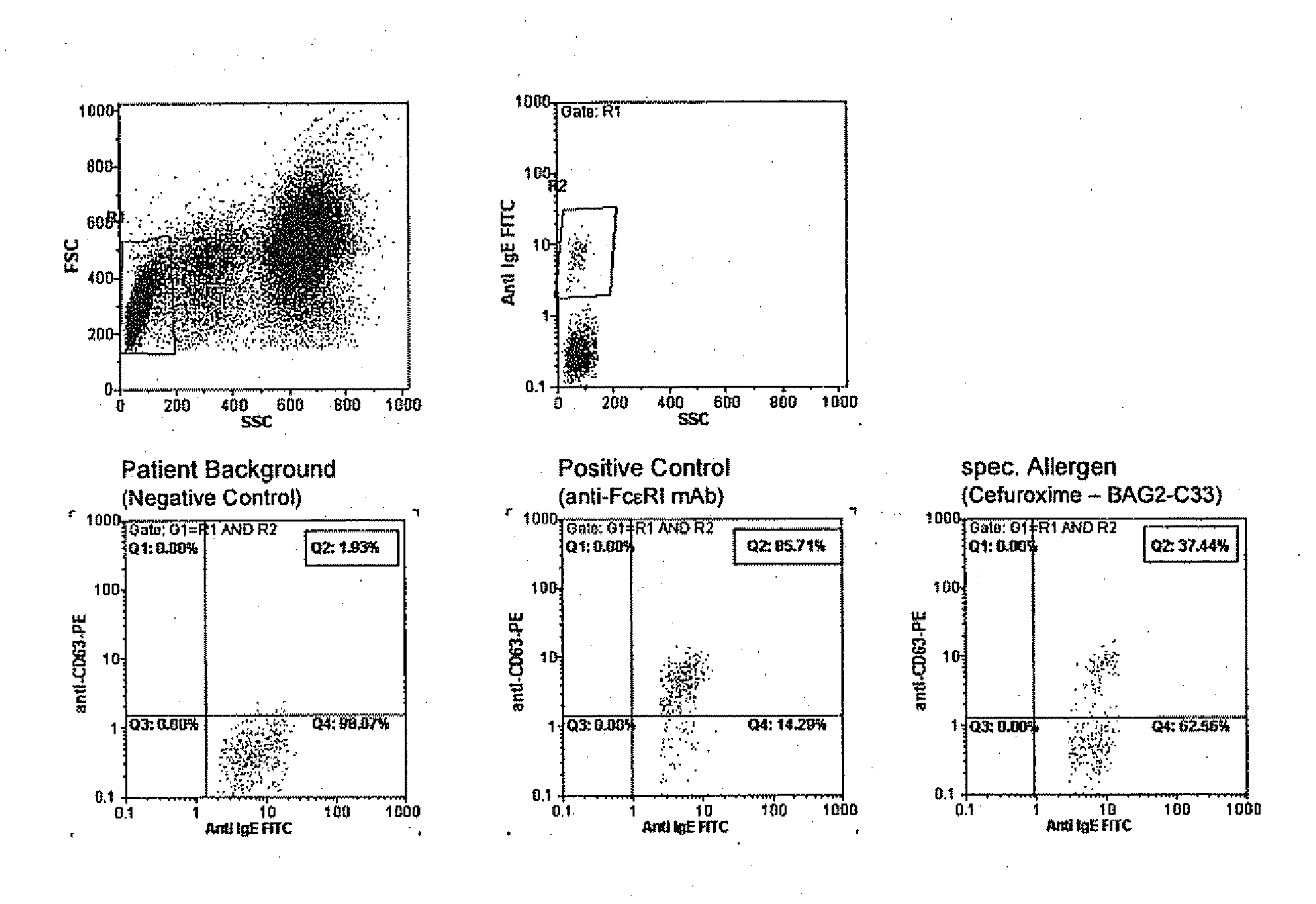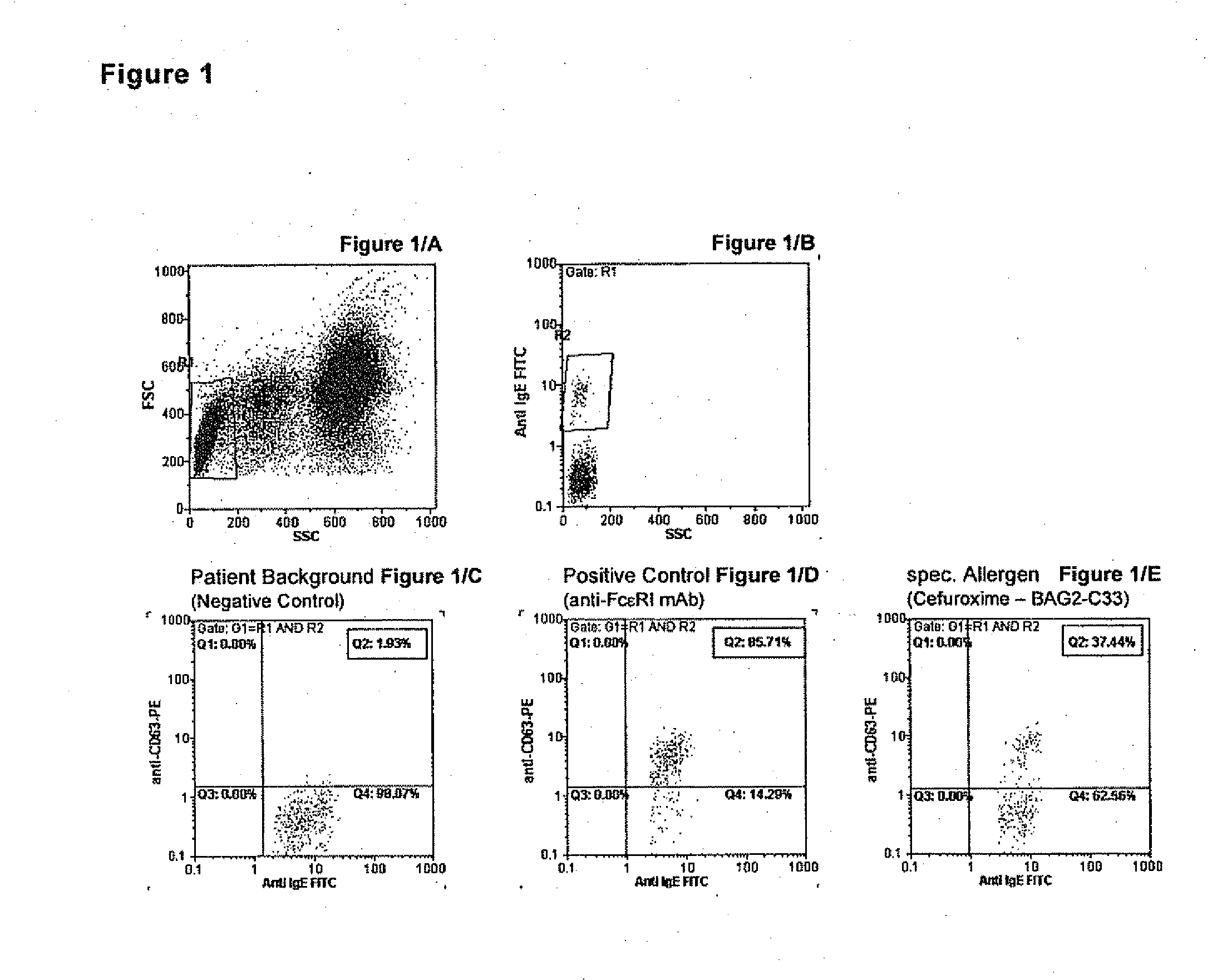Allergy test based on flow cytometric analysis
a flow cytometric and allergen-induced technology, applied in the field of flow cytometric analysis of allergen-induced basophil activation, can solve the problems of unsuitable routine allergy diagnosis, unspecific test, and low positive reaction ra
- Summary
- Abstract
- Description
- Claims
- Application Information
AI Technical Summary
Problems solved by technology
Method used
Image
Examples
example 1
EDTA vs. Heparin vs. ACD (Citrate) Blood
[0284]Blood from healthy blood donors or allergic patients was drawn into three different venipuncture tubes containing as anticoagulant either EDTA or Heparin or Citrate (ACD).
[0285]All blood samples were analysed according to Protocol 1 and stimulated with Stimulation Buffer (negative control=NC), anti-FcεRI mAb (positive Stimulation Control=PC) and with allergens as specified in FIGS. 5A, 5C and 5D. The results are expressed in percentage of CD63 expression.
[0286]A direct comparison of the three different blood preparations from a orchard grass (G3) allergic patient is shown in FIG. 5A. Heparin seems to unspecifically stimulate NC which is observed from time to time in other cases as well, whereas this is not seen here and is also not reported in other cases for ACD or EDTA blood, PC and G3 (50 ng / ml) are clearly positive with all blood samples, however EDTA samples give slightly higher stimulation reactions.
[0287]EDTA, ACD or Heparin venip...
example 2
Diluted vs. Purified (Washed) Blood Cells
[0290]The cellular reactivity depends very much on the conditioning of the blood cells before stimulation, i.e. the matrix for the stimulation reaction is very crucial. It must contain heparin, calcium and, preferably, IL-3 (except for specific applications such as the follow up of insect venom immunotherapy), but plasma factors may influence the reactivity of blood basophils, too.
[0291]Therefore, we established two protocols, one with diluted whole blood, wherein the EDTA blood sample is diluted 1 in 4 with cellular incubation buffer (the Stimulation Buffer) and another with purified blood, wherein the basophils were transferred from its plasma matrix to a plasma-free matrix such as the cellular incubation buffer by centrifuging and washing the blood cells. The following illustrative examples show the dramatic influences which the cellular preparation method may have on the reactivity of patients' blood cells in different clinical settings.
[...
example 3
Lysis Procedure
[0296]As just mentioned above, the removal of erythrocytes before analyzing the basophils on a flow cytometer is a prerequisite to correctly gate in resting vs. activated basophils and to get highly informative and quantitative results. In prior art methods, this is, beside the cell stimulation part, the most delicate and most time-consuming step in the entire analysis of quantitative basophil stimulation.
[0297]With the invented stimulation Protocol 2 combined with the CCR3 basophil selection marker it is possible to simplify and speed up or even automatize this process. In FIG. 9A, the detection and gating of basophils using the CCR3-PE selection marker is shown. From the left to the right panel, different erythrocyte lysing procedures are tested (LYR=Lysing Reagent; WB=Wash Buffer). The left panel shows a procedure as used in prior art methods including two centrifugation and one washing steps, the right panel clearly shows that neither a washing nor a centrifugatio...
PUM
| Property | Measurement | Unit |
|---|---|---|
| molecular weight | aaaaa | aaaaa |
| concentration | aaaaa | aaaaa |
| volume | aaaaa | aaaaa |
Abstract
Description
Claims
Application Information
 Login to View More
Login to View More - R&D
- Intellectual Property
- Life Sciences
- Materials
- Tech Scout
- Unparalleled Data Quality
- Higher Quality Content
- 60% Fewer Hallucinations
Browse by: Latest US Patents, China's latest patents, Technical Efficacy Thesaurus, Application Domain, Technology Topic, Popular Technical Reports.
© 2025 PatSnap. All rights reserved.Legal|Privacy policy|Modern Slavery Act Transparency Statement|Sitemap|About US| Contact US: help@patsnap.com



